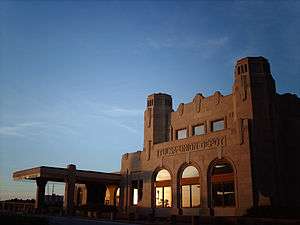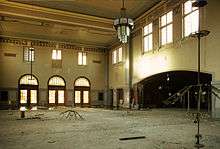Tulsa Union Depot
The Tulsa Union Depot (also known as the Tulsa Union Station) is the former central railway station for Tulsa, Oklahoma. It has since been turned into an office building. The Oklahoma Jazz Hall of Fame is currently headquartered in the former Depot.[1][2]
Tulsa Union Depot | |
|---|---|
 Tulsa Union Depot, 2009 | |
| Other names | Tulsa Union Station |
| Location | 5 S Boston Ave, Tulsa, OK 74103 |
| Other information | |
| Status | School and Museum |
| History | |
| Opened | May 13, 1931 |
| Closed | May 13, 1967 |
| Key dates | |
| 1980 | Reopened |
History
The Depot was built in 1931 by the Public Works Administration and was considered "the single best PWA symbol of hope for economic recovery during the bleak days of the depression."[3] It cost $3.5 million, paid for by a bond issue passed in 1927.[4] The Depot was the first central station in the city of Tulsa, and it unified the small Frisco (St. Louis-San Francisco Railway), Katy (M-K-T), and Santa Fe depots. Upon its completion, a crowd of over 60,000 people came to see the opening ceremonies, which included speeches, singing, dancing, and Indian stomp dancing. The event was even broadcast on radio. A new locomotive was unveiled, and the locomotive said to have brought the first passenger train into the city (Frisco's "Old 94") was showcased.[1] The depot opened "Tulsa's important front door." At its peak, the depot served 36 trains a day.[3]
The upper floor was the concourse level, with segregated waiting rooms on the east and west, flanking a central area for ticketing and baggage check-in. Direct access was via elevated entrances connected to the Boston and Cincinnati Avenue bridges over the St. Louis-San Francisco Railway tracks. An enclosed, elevated concourse extended north over five platform tracks; stairs led down to three passenger platforms. Escalators were later installed. The lower level served postal traffic, the Railway Express Agency (train-carried mail service) and passenger baggage; trucks were able to access this area directly via First Street.

Named passenger trains
| Operators | Named trains | Northern destination | Southern destination | Year begun | Year discontinued |
|---|---|---|---|---|---|
| Frisco Railway | Black Gold | terminus | Oklahoma City | 1938 | 1959 |
| Frisco Railway | Firefly | Kansas City | Oklahoma City | 1939 | 1960 |
| Frisco Railway | Meteor | St. Louis | Lawton | 1902 | 1964 |
| M-K-T | Bluebonnet | terminus | Galveston via Dallas and Houston | 1928 | 1958 |
| M-K-T | Katy Flyer | terminus | Galveston via Dallas and Houston | 1896 1900 | 1959 |
| M-K-T | Texas Special | St. Louis | San Antonio via Dallas | 1915 | 1965 |
| Santa Fe | Tulsan | Chicago | terminus | 1930 | 1971 |
Decline and renaissance
Because of declining passenger train travel and the rise of air travel and the Interstate Highway System, the depot was abandoned after hosting its last passenger train in 1967.[1] This was true even though the Santa Fe maintained passenger service to Tulsa until 1971; they utilized a separate station.[5]
In 1980, the Williams Companies purchased the structure, and tasked designer Urban Design Group and contractor Manhattan Construction (the same company that built the depot in 1931) with restoring the same.[4] In 1983 after completion, those companies leased space to make it their headquarters and offices.[4]
In 2004 Tulsa County purchased the building from the Williams Companies for $2.2 million, and used the balance of $4 million in Vision 2025 funds for renovations. The building was turned over to the Tulsa County Industrial Authority, which then signed a 99-year lease with the Oklahoma Jazz Hall of Fame for $1.[6] The Jazz Hall began operations at the site in 2007, though did not formally take control of the building until 2009.[7] The lease calls for the Jazz Hall to cover its own operating expenses; and, some controversy has arisen on occasions when bill payments have been late.[8] The Jazz Hall now calls the building the Jazz Depot.[9]
Before possible restoration of passenger train service to Tulsa via the Eastern Flyer proposal fell through,[10] Tulsa city councilors discussed the likelihood of using a portion of the Jazz Depot for its original purpose of serving as a downtown rail terminal for the city,[11] although other sites were also proposed such as the Center of the Universe location further to the northwest in Downtown Tulsa.[12]
Architecture
The Depot was built in an Art-Deco style by architect R.C. Stephens of St. Louis, MO. The Manhattan Construction Company served as the general contractor. The Art-Deco Style with machine styled elements was very popular, even a "something of a mania" in Tulsa.[2][3]
References
- Curtis, Gene (May 2, 2007). "Only in Oklahoma: By any name, Tulsa's rail facility was a jewel". Tulsa World.
- "Tulsa Union Depot". Tulsa Preservation Commission. Retrieved August 1, 2018.
- Wallis, Michael (2007). Way Down Yonder in the Indian Nation: Writings from America's Heartland. Norman, Oklahoma: University of Oklahoma Press. pp. 133–134. ISBN 978-0-8061-3824-4. Retrieved June 25, 2010 – via Google Books.
- Underwood, Bill (March 19, 1997). "Union Depot Train Station Rescued by Williams Companies After Years of Neglect". Tulsa World. Retrieved June 10, 2015.
- "Santa Fe Depot". Tulsa Foundation for Architecture. Retrieved January 25, 2019.
- Hylton, Susan (May 18, 2004). "Jazz hall to call depot its home". Tulsa World. Retrieved June 10, 2015.
- Canfield, Kevin (May 30, 2010). "Deal near for jazz nonprofit to run depot". Tulsa World. Retrieved June 10, 2015.
- Canfield, Kevin (October 15, 2012). "Jazz Hall pays bills, will remain at Union Depot". Tulsa World. Retrieved June 10, 2015.
- "Facility Rental". Oklahoma Jazz Hall of Fame. Retrieved June 23, 2020.
- "OKC-to-Tulsa passenger rail service falls through". Randy Ellis, Tulsa World, August 6, 2019. Retrieved August 6, 2019.
- Wade, Jarrel (December 5, 2014). "Council discusses potential train station for downtown Tulsa". Tulsa World. Retrieved June 10, 2015.
- "What happened to passenger rail service between Tulsa and OKC?". KJRH TV Channel 2. Retrieved January 25, 2019.
External links
| Wikimedia Commons has media related to Tulsa Union Depot. |
- Tulsa Union Depot Pictures in the Tulsa City-County's Beryl Ford Collection
- Oklahoma Jazz Hall of Fame
| Preceding station | Atchison, Topeka and Santa Fe Railway | Following station | ||
|---|---|---|---|---|
| Terminus | Tulsa – Kansas City | Mohawk toward Kansas City, Missouri | ||